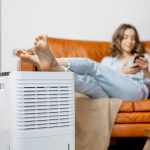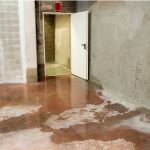Table of Contents
How to Maintain Proper Humidity Levels in Your Home
The ideal humidity range for homes is 30-50%. Keeping humidity within this range helps avoid issues like dry air, mold growth, and structural damage. Humidity levels fluctuate daily and seasonally based on outdoor conditions. Using tools like hygrometers, humidifiers, dehumidifiers, ventilation, and moisture control are key to regulating indoor humidity.
What is Humidity and Why is it Important to Control in Your Home?
Humidity refers to the amount of moisture or water vapor present in the air. Indoor relative humidity levels have a significant impact on human health, home maintenance, and comfort.
Properly controlling humidity helps create ideal indoor environments. Low humidity under 30% can irritate respiratory systems, dry out skin and surfaces, and cause structural issues. High humidity over 50% enables mold growth, bacteria, pests, odors, and condensation.
According to the Environmental Protection Agency (EPA), keeping indoor relative humidity between 30-50% is recommended. This helps reduce particulates like dust mites, mold spores, and bacteria that can worsen allergies and asthma. It also minimizes expansion and contraction of materials that can cause structural home damage over time.
Recommended Humidifier
 |
Top Pick For “Over-All” Best Humidifier Levoit LV 6000S View On Amazon |
What is the Ideal Humidity Level for Homes?
The ideal humidity range for homes is 30-50%.
Below 30%, indoor air is too dry and can cause issues like:
- Dry, itchy skin and throat
- Chapped lips
- Nasal discomfort
- Increase in static electricity on surfaces
Above 50%, indoor air becomes too humid. High humidity can lead to:
- Mold growth
- Dust mites
- Bacteria growth
- Musty, stale odor
- Peeling paint
- Water condensation on windows
The optimal humidity range varies slightly by season:
- Winter: 30-40% humidity
- Summer: 40-50% humidity
Aim for lower humidity in winter when outdoor air is drier. In summer, higher humidity helps homes feel cooler through evaporative cooling.
Problems Caused by Low Humidity Under 30%
Indoor relative humidity below 30% is considered too low. Some issues caused by excessively dry indoor air include:
- Dry, flaky skin – Low moisture deprives skin of water, allowing dead skin cells to accumulate.
- Chapped lips – Lack of moisture leads to cracking, irritation, and discomfort.
- Irritated, dry throat – Nasal passages and throat easily become inflamed without sufficient moisture.
- Increase in static electricity – Dry air prevents static charge dissipation, leading to more shocks.
- Furniture damage – Wooden furniture shrinks and splits without enough humidity.
- Peeling wallpaper – Wallpaper glue fails leading to curling edges when the air is too dry.
- Wood floors contracting – Hardwood planks shrink and gap without sufficient moisture.
Very low humidity can make indoor spaces uncomfortable for occupants. It also gradually causes cosmetic and structural issues in homes.
Problems Caused by High Humidity Above 50%
Indoor relative humidity above 50% is considered too high. Some problems caused by excessively humid indoor air include:
- Mold growth – Dampness enables mold spores to thrive and spread on surfaces.
- Dust mites – Microscopic mites proliferate in humid conditions, worsening allergies.
- Bacteria and microbial growth – Humidity nurtures bacteria growth, particularly in damp areas.
- Musty, stale odor – Excess moisture causes unpleasant “moldy” smells.
- Peeling paint and wallpaper – Water gets behind surfaces, causing failure and peeling.
- Water condensation – High humidity condenses into water droplets on cooler surfaces like windows.
Prolonged high humidity creates ideal conditions for mold, bacteria, pests and structural damage in homes. It also causes unpleasant odors.
How to Measure Humidity
To monitor humidity levels, use a hygrometer. Hygrometers measure and display the amount of moisture in the air.
There are digital and analog hygrometers:
- Digital hygrometers provide more precise measurements, typically within 2-5% accuracy.
- Analog hygrometers have a physical dial indicator. They are prone to greater inaccuracy.
When using a hygrometer, place it:
- Away from windows, vents or exterior walls
- At human height level in the room
- Check humidity in different rooms – levels can vary
Take humidity readings at different times of the day. Outdoor humidity impacts indoor levels. Only rely on hygrometer data when the sensor is properly calibrated according to manufacturer instructions.
Ways to Increase Low Humidity Under 30%
If indoor humidity drops below 30%, there are several methods to raise it:
- Use a humidifier – warm or cool mist types, filters help reduce minerals in water
- Take steamy showers
- Boil water on the stove so the steam evaporates
- Hang wet towels to allow evaporation
- Use indoor houseplants – the transpiration adds moisture
Operating a humidifier is the most effective way to increase humidity. Humidifiers release water vapor into the air to raise humidity levels. They come in warm and cool mist varieties:
- Warm mist humidifiers boil water to create steam. They can help heat rooms.
- Cool mist humidifiers use ultrasound waves or impellers to produce water droplets. No hot surfaces.
Humidifiers may disseminate minerals in water through the air. Using distilled water and replaceable filters can help reduce mineral dust.
| Best Anti-Microbial Humidifier
PureGuardian H5450BCA |
 |
Ways to Decrease High Humidity Above 50%
If indoor humidity rises above 50%, there are several methods to lower it:
- Use a dehumidifier – absorbs excess moisture, empties into tank or drain
- Turn on exhaust fans when bathing or cooking
- Open windows when outdoor humidity is lower
- Run the AC which lowers humidity by cooling air
- Use dehumidifying crystals or bags
- Clean and disinfect damp areas regularly
Operating a dehumidifier is the most effective way to lower high humidity. Dehumidifiers draw moisture from the air and collect it in a tank or drain it away. This lowers relative humidity.
Dehumidifiers work best at higher temperatures above 70°F. Lower temperatures limit their moisture removal capacity. If high humidity persists, a larger capacity dehumidifier may be needed.
Controlling moisture sources is also key to lowering humidity. Fix any plumbing leaks, dry out damp spaces, and ventilate areas where moisture accumulates like kitchens and bathrooms.
Tips for Maintaining Proper Humidity Levels
Here are some tips for maintaining proper humidity levels between 30-50% in your home:
- Monitor indoor and outdoor humidity daily using a hygrometer
- Adjust humidifier/dehumidifier settings accordingly
- Clean humidifiers/dehumidifiers regularly as instructed
- Change out HVAC air filters monthly
- Allow good air circulation inside the home
- Address any moisture sources like leaks, condensation
- Run a dehumidifier in damp basements
- Ventilate kitchens and bathrooms when in use
- Use exhaust fans when cooking, showering, etc
- Monitor humidity in different rooms and adjust as needed
Use a combination of monitoring, humidity control devices, ventilation, and moisture management to maintain ideal indoor humidity year-round.
Ideal Humidity Level by Room
Ideal humidity levels can vary slightly by room depending on the room size, contents, and activities. Here are some general room humidity guidelines:
| Room | Ideal Humidity Range |
|---|---|
| Living Spaces | 40-50% |
| Bedrooms | 40-50% |
| Bathrooms | 30-40% |
| Basements | 30-50% |
| Attics | 30-40% |
| Crawl Spaces | 30-40% |
| Laundry Rooms | 30-40% |
Living spaces and bedrooms where people spend a lot of time generally require 40-50% humidity for comfort. Only allow higher 50%+ humidity in these rooms for short periods in very dry climates.
Bathrooms, basements and attics require drier conditions to control moisture. Reduce risk of condensation and mildew by keeping humidity under 50% in these areas.
Ideal Humidity by Season
Outdoor conditions impact indoor humidity levels. Here are tips for maintaining proper humidity by season:
- Winter – Lower humidity to 30-40% to compensate for very dry outdoor air circulating indoors.
- Summer – Allow higher humidity 40-50% for evaporative cooling effects as long as outdoor air is not too humid.
- Rainy/humid seasons – Use dehumidifiers and ventilation to prevent excess moisture indoors.
- Dry seasons – Increase humidity levels using humidifiers.
Adjust indoor humidity based on outdoor conditions for comfort and to minimize energy costs. Humidity sensors in smart thermostats can automate this process.
Health Risks of Improper Humidity Levels
Maintaining proper indoor humidity has health implications. The EPA recommends humidity levels between 30% and 50% for the following reasons:
- Reduces growth of mold, mildew, and dust mites that can aggravate allergies and asthma.
- Lessens survival and spread of viruses, bacteria, and other microbes.
- Prevents dryness that can irritate respiratory illnesses like coughs and laryngitis.
- Limits excess moisture that enables bacteria and gases to be released from building materials.
Low humidity can dry out and irritate nasal passages, skin, lips, and throat linings. High humidity fosters the spread of airborne allergens and respiratory infections.
In addition to health effects, improper humidity damages furnishings, electronics, and the home itself over time.
Other Tips for Controlling Indoor Humidity
Here are some other tips for managing humidity levels in your home:
- Insulate cold water pipes to reduce condensation.
- Look for signs of excess moisture like water stains and musty odors.
- Install moisture barriers like vapor retarders in basement and crawl spaces.
- Seal any air leaks around windows, doors, pipes, and wiring.
- Check that vent fans exhaust to the outdoors, not the attic.
- Route gutters and downspouts away from the foundation.
- Slope the ground away from the house’s foundation.
Humidity control requires an integrated approach of monitoring, active systems like humidifiers/dehumidifiers, ventilation, and diligent moisture management.
Conclusion
Proper humidity control between 30-50% is vital for human health, reducing pests and allergens, preventing structural home damage, and overall comfort.
Use hygrometers to actively monitor humidity levels indoors and out. Increase low humidity with humidifiers. Decrease high humidity with dehumidifiers, ventilation, AC, and controlling moisture sources.
Maintaining the 30-50% recommended range requires careful monitoring and adjusting devices and household habits based on humidity readings, seasons, and room functions.
But putting in the effort provides huge benefits for respiratory health, comfort, well-being and protecting the home itself from deterioration.
With the right combination of tools and diligence, you can effectively regulate humidity in your home.







